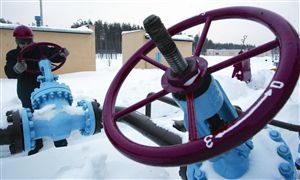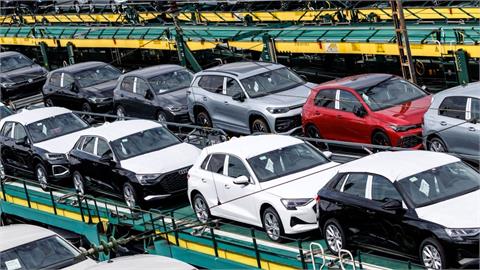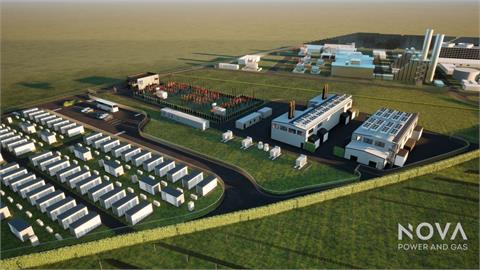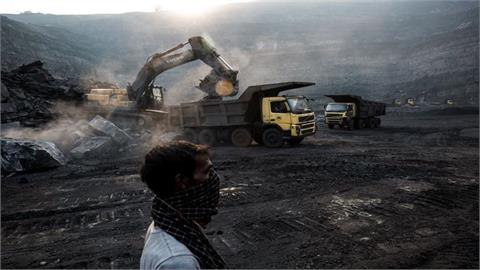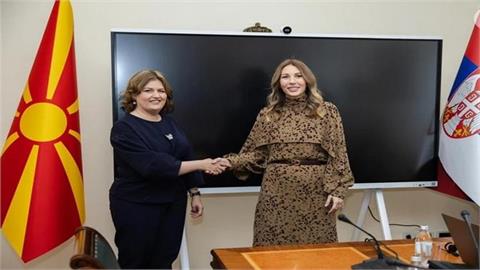by Costis Stambolis* The latest Russian- Ukrainian crisis and its serious repercussions on energy trade between Russia and the EU amply demonstrates the importance of energy security in the prevailing economic and financial framework which underpins the functioning of modern states
Table A:Coal in SE Europe (2013)
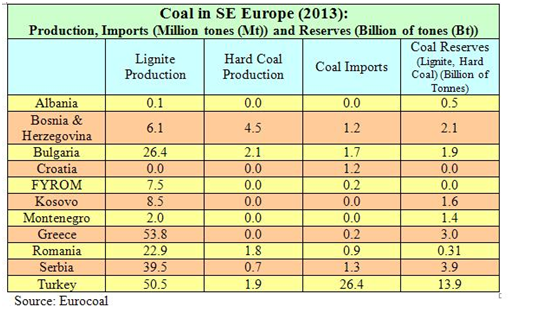
What is apparently lacking from present EU energy policies is a clear direction in the area of energy supplies and particularly, the "security of supply” dimension at both national and EU level. Until now most countries in the EU had a well developed local supply basis- on the strength of their extensive coal reserves as shown in Table A- which covered the vast majority of their needs for power generation and relied on oil imports, in widely differing degrees of dependency, to mainly cover transportation needs and in some cases power generation. Diversification of energy supply, although necessary and accepted by many countries as a top national priority, was for most not an easily attainable objective. Consequently, each country had developed its own agenda and operational procedures to tackle anticipated and serious energy supplies disruptions, mostly focused on oil supply, where IEA’s compulsory stock maintenance was the norm.
Over the last ten to fifteen years everything has changed in the energy supply front as a result of EU internal market energy rules, the growing imports of natural gas (mainly used for power generation), the emphasis on RES use and the introduction of disincentives for coal and lignite use for power generation. At the same time, neither the EU nor individual states, (with the exception of North Sea countries) have pursued strong and consistent policies for the development of indigenous hydrocarbon resources, with the result that oil and gas import dependency has risen to unacceptable high levels as is the case in SE Europe (see Table B). Far from being a theoretical notion this import dependency has translated into actual energy scares as most countries in SE Europe have twice experienced gas import shortfalls (following the Russo-Ukrainian crises in the winters of 2006 and 2009) and are most likely to face a third major interruption as the current Russian Ukrainian crisis continues to unfold.
Table B: Oil and Gas Production and Consumption
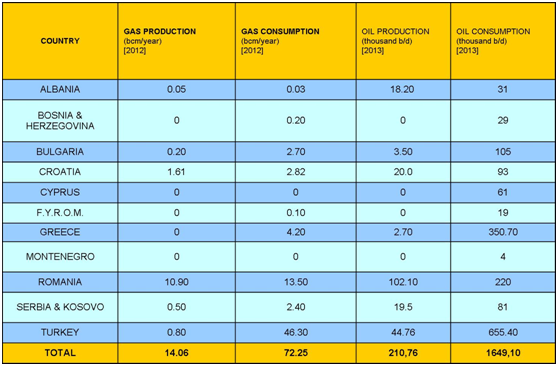
As many analysts note the current Russian-Ukraine crisis has put energy security at the top of the agenda once again and forcibly reminded Europe of its dependence on Russia, particularly for gas. Russia accounts for almost 40 per cent of Europe’s gas imports and therefore meets some 27 per cent of total European gas demand. For some countries such as Bulgaria, Slovakia, Hungary and those in the Baltic the dependence is total. Greece is also highly dependent with 65% of Russian gas imports. Turkey, too, relies for almost 50% of its imports on Russian gas. For ex Soviet Block countries, that dependence is a legacy of history. For others, like Greece and Turkey, is the result of failed policies and wrong decisions which have prevented them from developing a well balanced and diversified energy resource base. Whichever the cause of this deficiency, which as we have clearly seen in the not too distant past and we are witnessing once again, it is provingto be a major disruptive force for the smooth operation of the market and with dire consequences for almost all aspects of economic activity. In that sense, the need to introduce and match energy security across the whole of the EU to the current political realities emerges as a top priority in the current EU policy agenda.
In a latest EU policy paper entitled "Commission Staff Working Document: In-depth study of European Energy Security” alongside the focus on energy security is a reiterated plan for the reduction of emissions. To align the two objectives, the authors focus on the ways in which Europe can produce more of its own energy. Shale gas and new nuclear are included – for those who want them – but the main emphasis is on renewables such as wind and solar. "This is where the echoes of the CAP are loudest. It is a short step from saying that Europe should meet more of its own needs to providing support payments for production”, notes Nick Butler in the Financial Times.
At the same time, it is clear that a common energy policy does not mean that every country will be required to use the same sources of supply. For instance Germany will not be required to build a new generation of nuclear power stations. The French will not be forced to develop shale gas. But then the CAP has never required everyone to grow the same crops or to farm the same cattle. Instead, this version of a common policy is about the integration of objectives across the 28 member states. Different countries will make different contributions, but all will come within a framework driven by the twin objectives of security of supply and the reduction of emissions. However, in order to enhance security of supply several key pan European projects will need to be implemented over the coming years in order to facilitate the flow of electricity and gas across national borders. These range from the expansion of the current electricity grid through the establishment of regional hubs and interconnections, the construction of majorinter-regional gas pipelines (i.e. TAP- TANAP, South Stream) and several country to country interconnectors and the introduction of new LNG Terminals (land based and floating ones).
In the EU’s concept of energy security, as outlined in the above EC staff Working Document, there is no mention of the costs involved in improving energy security and the unavoidable impact on European competitiveness. Shale gas and tight oil is giving the US a dramatic competitive advantage, while Europe is losing market share and jobs in all the energy intensive industries. But as with the CAP, the fact that supplies could be imported more cheaply is not a key factor and therefore it is not even discussed. Of course, Europe could meet all its own electricity needs from renewables but the cost – as the Germans, the Greeks, the Bulgarians and the Italians are finding – is punishingly high. The message of the document which clearly reflects current EU thinking and in fact was adopted by EU’s June Summit Meeting, is that imports are bad, and should be reduced. Where they cannot be reduced, the sources of supply should be diversified.
It seems that Eurocrats assume that energy is solely a matter for public policy and consequently economics and the specific characteristics of certain countries are missing elements from that discussion(i.e. Greece’s and Portugal’s island environment). Also, there is nothing on science or the potential for technical change, which is regrettable, given Europe’s strong, scientific base. The technology of energy supply and consumption is moving rapidly and it would be useful to see Europe doing more to match the efforts being made by the US and China.
On the key issue of energy security on the one hand we have EU’s almost academic approach to energy security and on the other we have the harsh daily reality that countries in SE Europe face, as they count oil and gas storage levels and try to match energy flows and needs through a delicate balancing act. To them, projects such as TAP-TANAP, the South Stream, planned LNG terminal such as the Krk LNG Terminal in Croatia and Greece’s FSRU units in northern Aegean, and local vital gas links like the Greece- Bulgarian interconnector (IGB), the Bulgaria- Serbia interconnector (IBS) and the Bulgaria – Romania interconnectors (IBR) acquire a special significance.
Indicative of the anxiety which currently prevails in SE Europe over energy supplies is the Greek government’s request to the EU of August 21 to set up a backup plan to ensure liquefied natural gas (LNG) is available for Balkan countries in the event of potential disruptions to Russian gas supplies stemming from the crisis in Ukraine. In a letter sent to European Energy Commissioner Guenther Oettinger, Greek Energy Minister Yannis Maniatis proposed an EU emergency mechanism to ensure that surplus amounts of lower-priced LNG are reserved for EU member states with gas shortages instead of being sent to other destinations.
Russia cut off natural gas supplies to Ukraine on June 16, although they have since been restored following the EC-brokered agreement between Russia and Ukraine of October 30, in a dispute over unpaid bills, prompting concerns about possible disruptions to flows of gas which transits Ukraine en route to Europe. Greece imports about 70% of its natural gas from Russia via Ukraine. It also imports gas from Azerbaijan through Turkey and from a domestic LNG storage facility. Maniatis warned that a serious disruption in supplies to Europe was possible during the coming winter and that Greece and other Balkan countries could be hit harder that other EU markets. "We have taken this initiative so that Europe launches a joint solidarity mechanism, which will secure LNG supplies in case of a stoppage," Maniatis told Reuters. Market sources meanwhile note that the risk always remain that surplus LNG might be sent to Asia.
RES which is in abundance in SE Europe is another issue of contention. The role of RES in addressing energy security issues and their contribution in providing a viable alternative, we believe, has been hugely overstated over the last two to three years and continues unwisely to dominate the energy agenda. The wider use of RES in only one of the responses to energy security alarms, which, in fact, presupposes a solid commitment to a long term strategy for their development and penetration into the energy mix. The most effective policy response aims at a diversification of energy inputs, with RES only one of them and albeit a small on at present. The following comments are relevant:
i.The most effective response to energy security aims at a diversification of the energy mix based on different types of energy inputs (i.e. solid fuels, hydro, nuclear, natural gas, RES) with RES being only one of them and albeit a small one at present.
ii.Renewables in one of several options for a successful diversification of the energy mix.
iii.Energy efficiency improvements through demand side management and technological innovation can cost-effectively mitigate the large-scale impact of energy supply disruption in the electricity and heat sectors, and to a limited degree in the transport sector too.
iv.A combination of demand side management and energy efficiency measures can reduce the dependence on fuels for the production of electricity, heat and transport fuel
As a general observation one could say that the increased participation of RES in the energy mix can play an important role in strengthening energy security at both country and regional level. Table C shows the contribution of RES, including large hydro, in SE Europe countries. However, a high RES percentage participation in the energy mix can be misleading because of the intermittent nature of RES. In that sense there is still considerable ground to be covered for increasing RES actual contribution in the energy mix of SEE countries. Large scale application of Energy Efficiency measures can also contribute greatly toward energy security by curtailing energy demand; however their contribution is not easily quantifiable.
Table C: Installed Renewable Electricity Capacity in SE Europe in 2013
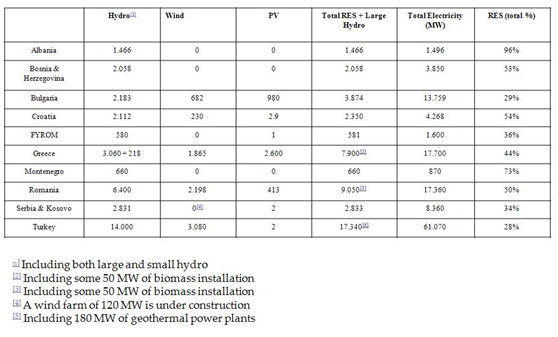
As far as the energy security implications of renewable energy technologies are concerned one can point out that although RES are typically indigenous resources and can help reduce dependence on energy imports, they have certain constraints:
(a)RES are intermittent in nature and therefore cannot be relied upon to provide alternative power generation supply in case of emergencies
(b)RES are widely, (but unevenly), distributed and their use for electricity generation can minimize both transmission losses and costs only when they are located close to the demand load of end-users: so called " distributed” generation
(c)Relatively high capital costs per unit of capacity installed remain for many RES’s – in spite of significant cost reductions as a result of advancements in technology and learning experience (this is offset to some extent by a zero fuel cost over the life of the system)
Furthermore, the extent to which RES can contribute in bolstering energy security depends on several facts such as the installed electricity capacity of RES and its relation to the overall power generation capacity of the country concerned, secondly the grid development and its operational level which allows for maximum utilization of the electricity produced, thirdly the availability of energy storage mechanisms (both dispersed and pumped storage).Today we witness various levels and speeds of RES and Energy Efficiency development in the different countries of SE Europe both in terms of installations and participation in the energy balance. In fact there is considerable divergence between the various countries as it is shown in the data presented. The same applies for the state of the electricity grids of the various countries. Consequently the role of RES in the integration of regional energy markets (i.e. electricity and gas) is marginal at this stage since the focus is, and will remain at least until 2020, on grid upgrading and their further expansion. However, the anticipated and much needed addition of sizeable energy storage capacity in conjunction with further RES development is likely to propel RES, after 2020, in the front line of power generation and participation in the national energy mix of the SEE countries. The addition of energy storage is thus expected to correct and improve the intermittent nature of RES power generation, thus improving predictability of RES availability in the context of daily electricity market operation.
Table D: Mega Energy Projects in SE Europe and the East Mediterranean in SE European countries
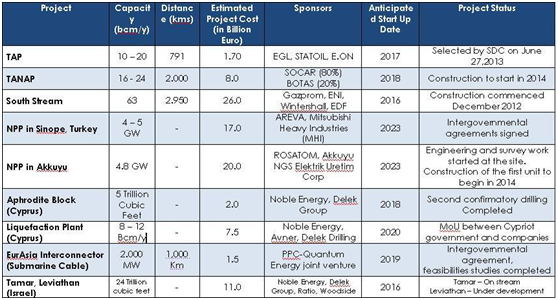
In addressing the present impasse on energy supplies in SE Europe it seems that the implementation of a wide variety of interconnectors and gas storage projects and new gas pipeline routes is the only sure way at present to increase effectively and relatively quickly the security of supply in the region. Any arguments against that- as we have recently seen in the case of EU’s legalistic objections to South Stream- only help alienate national policies and priorities from a supposedly overall common energy policy. SE Europe’s experience to date shows that the only reliable way to meet the challenges stemming from major geopolitical rifts (not of the making of the countries in the region) such as the present Russian – Ukraine crisis is for each country to pursue its own highly prioritized energy agenda in close coordination with its immediate neighbours with whom it shares borders and energy interconnections. A common energy pool and a fully integrated and easily accessible electricity and gas flow system, which could serve the needs of various countries, whether this is electricity or gas, is still far from becoming a reality. We may have to face few more energy supply crises in order for such noble plans to become reality.
*Executive Director of
the Institute of Energy for SE Europe (IENE)
